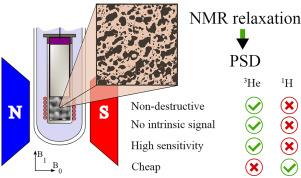氦-3核磁共振是研究粘土基岩石孔隙分布的有效探针
IF 2.1
3区 地球科学
Q2 GEOSCIENCES, MULTIDISCIPLINARY
引用次数: 0
摘要
从评价多孔介质基本性质的角度对两种核磁共振探针进行了比较和讨论。第一个和传统的是水的1H核磁共振,第二个是基于3He核磁共振。这两种方法都可以通过测量探针核的横向和纵向磁化弛豫时间以及弛豫时间之间的T1−T2相关图来估计孔隙率和孔径分布(PSD)。将两种探针应用于粘土丰度相对较小的砂岩的比较表明了3He方法的有效性。在被水破坏的富粘土样品上证明了3He核磁共振技术的优越性。所获得的psd相关结果表明,3He方法适用于各种富泥地层的表征,可用于常规水核磁共振无法研究的非常规特稠油储层、致密页岩等。本文章由计算机程序翻译,如有差异,请以英文原文为准。

Helium-3 NMR as a valid probe to study pore distribution of clay-based rocks
Two probes for nuclear magnetic resonance (NMR) technique are compared and discussed in evaluation terms for basic properties of porous media. The first and conventional one is 1H NMR of water, the second one is based on 3He NMR. Both approaches allow to estimate the porosity and pore size distribution (PSD) by measurements of the transverse and longitudinal magnetization relaxation times of the probe nuclei, as well as a correlation map between relaxation times. The validity of 3He approach is shown by the comparison of both probes applied to sandstones with a relatively small clay abundance. The advantages of 3He NMR technique are demonstrated on the clay-rich samples that get destroyed by water. The obtained PSD-relevant results show that the 3He method is suitable for characterization of various clay-rich formations and can be used to study unconventional extra-heavy oil reservoirs, tight shales, etc., where a conventional water NMR is inapplicable.
求助全文
通过发布文献求助,成功后即可免费获取论文全文。
去求助
来源期刊

Journal of Applied Geophysics
地学-地球科学综合
CiteScore
3.60
自引率
10.00%
发文量
274
审稿时长
4 months
期刊介绍:
The Journal of Applied Geophysics with its key objective of responding to pertinent and timely needs, places particular emphasis on methodological developments and innovative applications of geophysical techniques for addressing environmental, engineering, and hydrological problems. Related topical research in exploration geophysics and in soil and rock physics is also covered by the Journal of Applied Geophysics.
 求助内容:
求助内容: 应助结果提醒方式:
应助结果提醒方式:


